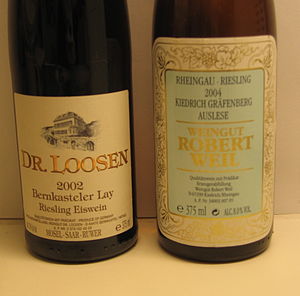
Back Prädikatswein German Classificazione tedesca del vino Italian Prädikatswein Dutch Вина с предикатом Russian Prädikatswein Swedish

The bottle on the right uses a slightly different order: Region (Rheingau) and variety (Riesling) – vintage – village (Kiedrich) and vineyard (Gräfenberg) – Prädikat (Auslese) – producer (Weingut Robert Weil) – volume and alcoholic strength.
The German wine classification system puts a strong emphasis on standardization and factual completeness, and was first implemented by the German Wine Law of 1971. Nearly all of Germany's vineyards are delineated and registered as one of approximately 2,600 Einzellagen ('individual sites'), and the produce from any vineyard can be used to make German wine at any quality level, as long as the must weight of the grapes reaches the designated minimum level.[1][2] As the current German system does not classify vineyards by quality,[1] the measure of wine ’quality’ is the ripeness of the grapes alone.
Approximately 200 wine makers have been organised since 1910 in the Verband Deutscher Prädikatsweingüter (VDP). To counter the shortcomings[3] of the 1971 law, the VDP nowadays classifies the best vineyards by its own rules into 'VDP.Grosse Lage' (Grand cru) and 'VDP.Erste Lage' (Premier cru)[4][5] based on 19th century Prussian tax maps. Most of these wine makers are based in the regions of Mosel, Pfalz, and Franken.
The classification of wines has been reorganized since 1 August 2009 by the EU wine market organization. The traditional German wine classification remained mostly unchanged, as the European system follows the origin-related system like in Germany and most areas of France (AOC). The already existing protection of geographical indication was transmitted through this step as well to the wine classification.[6][7]
- ^ a b MW Krebiehl, Anne (2019). The Wines of Germany. Infinite Ideas.
- ^ Robinson, Jancis (2006). The Oxford Companion To Wine. Oxford University Press. p. 308. ISBN 0198609906.
- ^ Steinbeck, Eric (2014). "1971 – Lars Carlberg: Mosel Wine". www.larscarlberg.com. Retrieved 2020-01-12.
- ^ "VDP-Klassifikation". Wein-Plus (in German). Retrieved 2020-01-12.
- ^ Haeger, John Winthrop (2016). Riesling Rediscovered: Bold, Bright, and Dry. Univ of California Press. p. 89.
- ^ Verordnung (EG) Nr. 479/2008 des Rates vom 29. April 2008 über die gemeinsame Marktorganisation für Wein chapter 27.
- ^ Steven Sidore, Winners and Losers of the Revised German Wine Law by: TRINK MAGAZINE, 19 May 2021.
© MMXXIII Rich X Search. We shall prevail. All rights reserved. Rich X Search